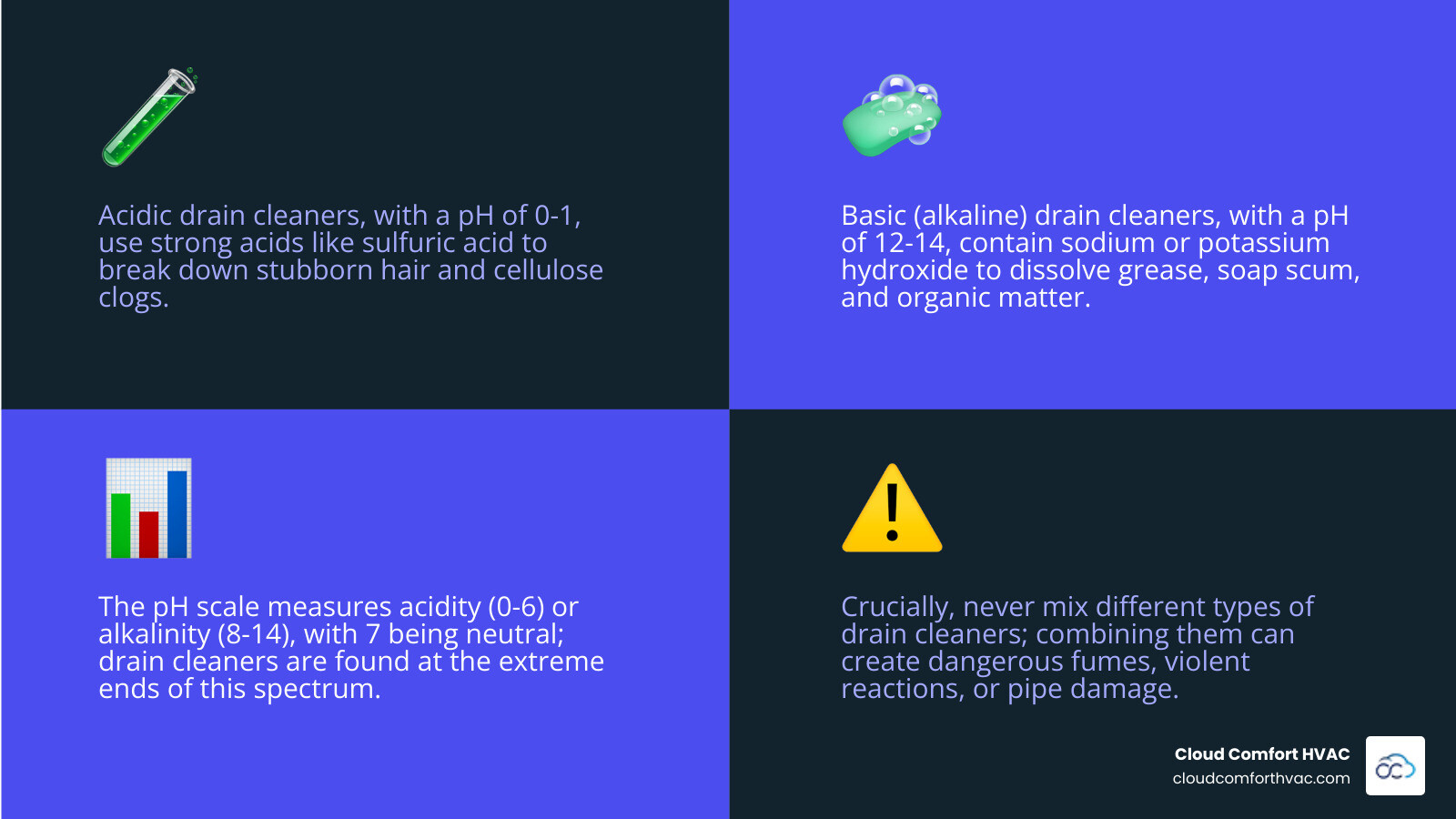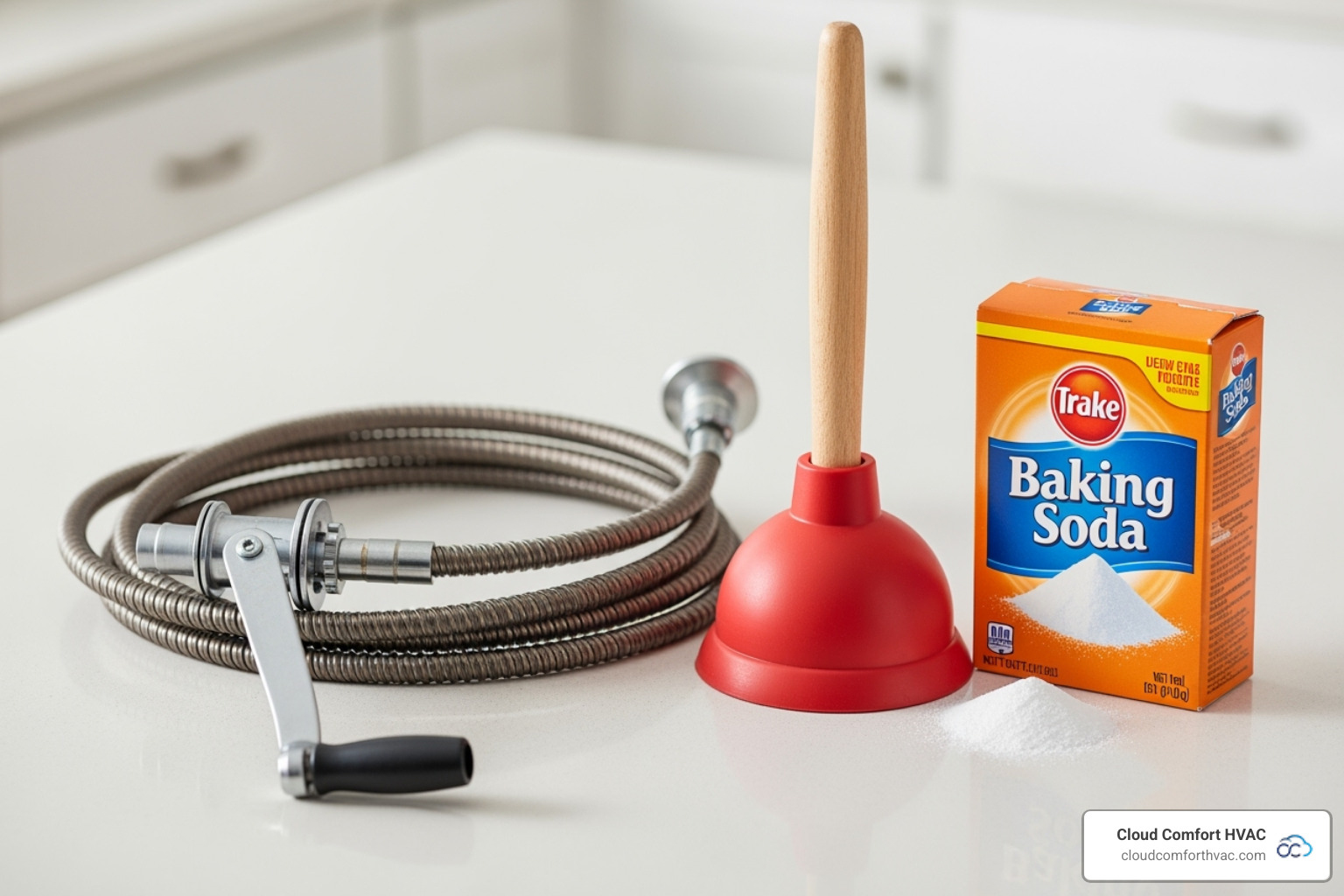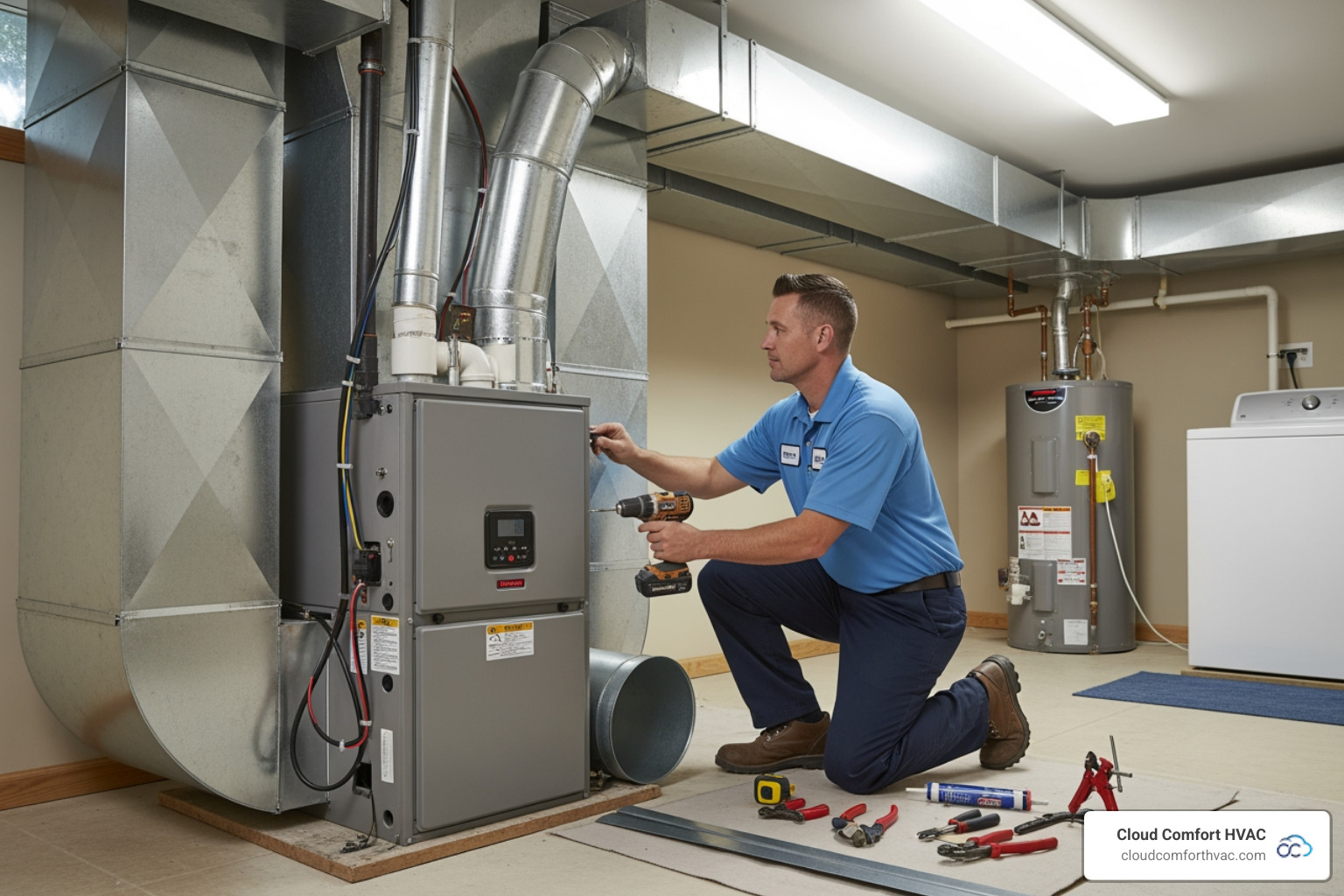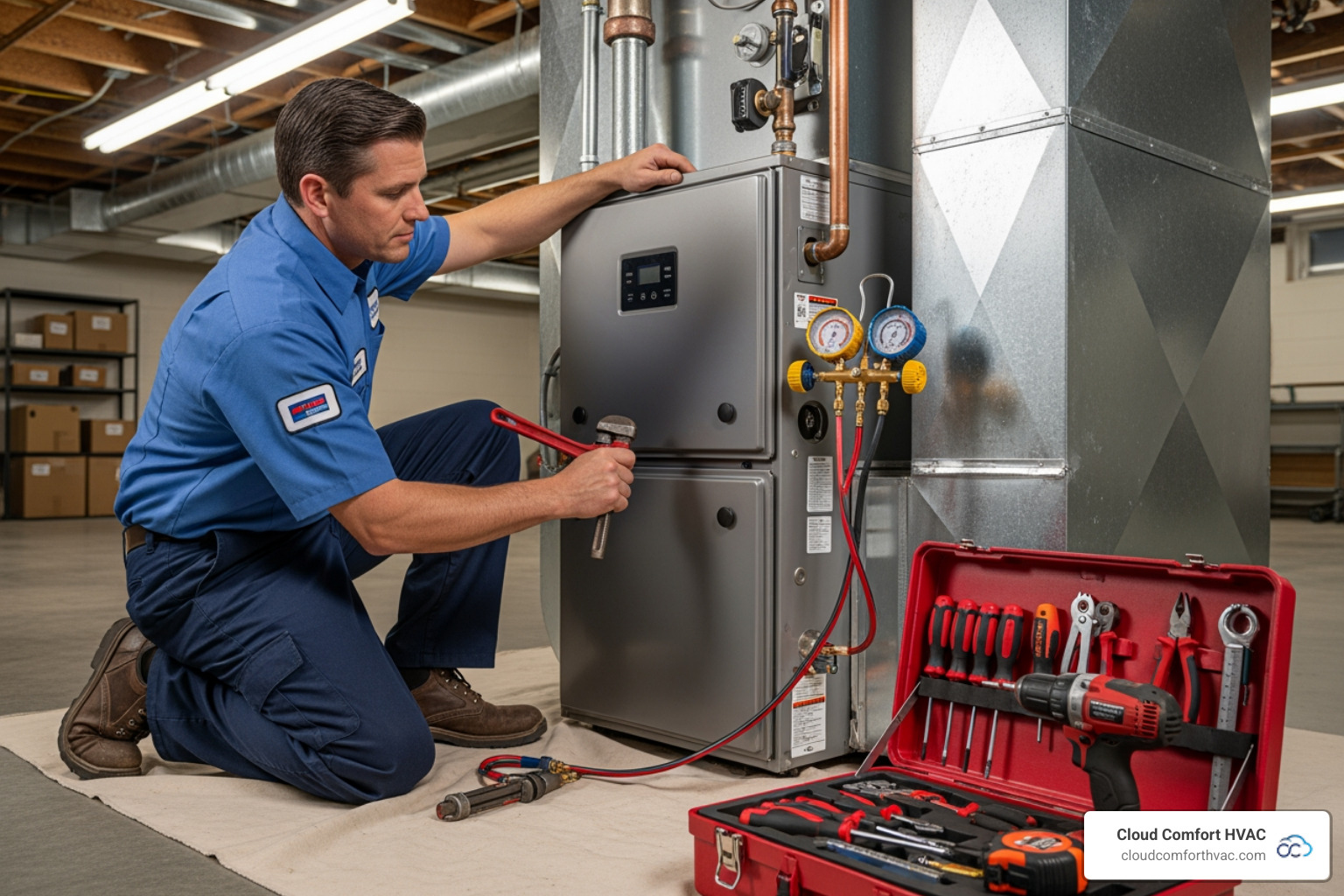Unclogging the Mystery: Understanding Drain Cleaner's Acidic and Basic Nature
Why Understanding Drain Cleaner Chemistry Matters for Your Home
When you're staring at a stubborn clog, you might wonder is drain cleaner acidic or basic before reaching for that bottle under your sink. The answer isn't simple: drain cleaners can be either acidic or basic (alkaline), and understanding which type you're using is crucial for both your safety and your pipes' health.
Quick Answer: Drain Cleaner pH Levels
- Basic (Alkaline) Drain Cleaners: pH 12-14, contain sodium hydroxide (lye) or potassium hydroxide
- Acidic Drain Cleaners: pH 0-1, contain sulfuric acid or hydrochloric acid
- Purpose: Basic cleaners dissolve grease and organic matter; acidic cleaners break down hair and cellulose
- Safety Note: Never mix different types of drain cleaners
Most household drain cleaners are basic (alkaline), working through chemical reactions that turn grease into soap-like substances. However, some professional-grade products use strong acids to tackle particularly stubborn blockages. The difference matters because these chemicals work differently, pose distinct safety risks, and can affect your plumbing in various ways.
If you're dealing with recurring drainage issues in your home, understanding the chemistry behind these products helps you make safer choices. For complex clogs or persistent problems, professional drain cleaning services offer expertise without the guesswork. When you need reliable help, Cloud Comfort HVAC's plumbing experts can diagnose and solve your drainage problems safely.

Understanding the Chemical Makeup: Is Drain Cleaner Acidic or Basic?
When you're standing in front of a backed-up sink, the last thing you want is a chemistry lesson. But here's the thing: knowing whether drain cleaner is acidic or basic can make the difference between solving your problem and creating a bigger one. At Cloud Comfort HVAC, we've seen what happens when homeowners grab the wrong bottle, so let's break down the science in a way that actually makes sense.
The secret to drain cleaners lies in the pH scale—that 0 to 14 range you might remember from school. Numbers below 7 are acidic (think lemon juice), numbers above 7 are basic or alkaline (like baking soda), and 7 is neutral (pure water). Drain cleaners live at the extreme ends of this scale, which is exactly what makes them so powerful at dissolving the gunk clogging your pipes.
Different clogs need different chemical approaches. That hairball in your shower drain? It responds differently than the grease buildup in your kitchen sink. That's why drain cleaners come in two distinct chemical varieties, each designed to tackle specific types of blockages.

Basic (Alkaline) Cleaners: High pH for Grease and Grime
Walk down any store aisle, and most drain cleaners you'll find are basic (alkaline) solutions with a pH between 12 and 14. These are the heavy hitters for everyday household clogs, and they're surprisingly clever in how they work.
The active ingredients are typically sodium hydroxide (also called lye or caustic soda) or potassium hydroxide. These powerful bases don't just push clogs through—they actually transform them into something that can wash away easily.
The magic happens through a process called saponification. When these alkaline cleaners meet the fats and oils coating your pipes, they literally turn that grease into soap. It's the same chemical reaction used to make actual soap, happening right there in your drain. Once transformed, the greasy mess dissolves and flows away with water.
But that's not all. Basic cleaners also break down proteins through alkaline hydrolysis, which is perfect for dissolving hair and food particles that get tangled in your pipes. The strong alkaline solution attacks the chemical bonds holding these materials together, turning solid clogs into liquid waste.
Here's a bonus: when you pour these cleaners into your drain, they generate heat. This exothermic reaction melts stubborn grease and speeds up the whole cleaning process. You might even hear a satisfying gurgle as the blockage gives way.
Basic drain cleaners excel at handling grease clogs from cooking oils, soap scum buildup in your bathroom, food particles that slip past your kitchen strainer, and even hair when it's mixed with soap and oils. If you're dealing with these common household headaches in Costa Mesa, a basic cleaner is usually your first line of defense.
Acidic Cleaners: Low pH for Tough Clogs
On the opposite end of the pH scale sit acidic drain cleaners, with pH levels between 0 and 1. These are the serious solutions—think of them as the drain cleaning equivalent of calling in reinforcements. They're often restricted to professional use, and for good reason.
The active ingredients here are strong acids like sulfuric acid and hydrochloric acid. These aren't your everyday household products. They're powerful and work through completely different chemical pathways than basic cleaners.
Through acid hydrolysis, these cleaners break down organic materials, but they're particularly effective against cellulose—the stuff that makes up toilet paper, tissues, and plant-based debris. Sulfuric acid is especially good at dehydration, essentially removing water from these materials and turning them into carbon and water. The clog literally shrinks and crumbles.
Like their alkaline cousins, acidic cleaners also generate significant heat when they react with water and organic matter. This isn't just a little warmth—we're talking serious heat that can melt through stubborn blockages and dramatically speed up the chemical reactions. It's this intense heat that makes them so effective but also so potentially dangerous.
Acidic cleaners are the go-to choice for severe hair clogs that resist other treatments, heavy tissue paper blockages, and other organic matter that just won't budge. These are the clogs that have you seriously considering calling a plumber—which, honestly, is often the smarter move when dealing with such powerful chemicals.
The extreme acidity and heat generation mean these products demand respect and proper handling. This is why we typically recommend leaving acidic drain cleaners to experienced professionals who understand the risks and know how to use them safely.
Acidic vs. Basic: A Side-by-Side Comparison
Now that we've explored how acidic and basic drain cleaners work, let's put them head-to-head. Understanding the differences between these two types isn't just academic—it's about choosing the right tool for your specific clog and, more importantly, protecting your plumbing system and your safety.
When you're wondering is drain cleaner acidic or basic, the answer affects everything from how quickly it works to what kind of damage it might cause. Let's break down the key differences in a way that makes sense for your home.
The Key Ingredients tell you a lot about what you're dealing with. Acidic drain cleaners pack heavy hitters like sulfuric acid and hydrochloric acid, while basic (alkaline) cleaners rely on sodium hydroxide (lye) or potassium hydroxide to get the job done.
How they work is where things get interesting. Acidic cleaners use acid hydrolysis and dehydration, essentially breaking down organic materials and sucking the water out of them. They generate intense heat in the process. Basic cleaners take a different approach—they turn fats into soap through saponification and break down proteins through alkaline hydrolysis, also creating significant heat along the way.
The best clog type for each cleaner varies based on their chemical action. Acidic cleaners excel at dissolving hair, cellulose (like toilet paper), and tough organic matter that's really stuck in there. Basic cleaners are your go-to for grease, soap scum, food particles, and general organic clogs that build up over time in kitchen and bathroom drains.
The pH levels sit at opposite extremes of the scale. Acidic cleaners register between 0 and 1—about as acidic as you can get—while basic cleaners clock in at 12 to 14, the upper reaches of alkalinity. Both extremes mean both types are incredibly reactive and potentially dangerous.
Potential pipe risk is where many homeowners run into trouble. Acidic cleaners are notorious for corroding metal pipes, including copper and galvanized steel, and they're particularly harsh on older plumbing systems. Basic cleaners can soften and damage PVC pipes if you leave them too long or use them incorrectly, and they can also harm aging metal pipes.
The reaction speed differs too. Acidic cleaners typically work very fast with vigorous, sometimes violent reactions. Basic cleaners are usually slower but still pack plenty of punch when breaking down clogs.
Perhaps most importantly, both types carry serious safety concerns. They're highly corrosive to your skin, eyes, and internal tissues. Both produce toxic fumes that can damage your respiratory system, and both generate significant heat that can cause burns. This isn't something to take lightly.
The bottom line? Both acidic and basic drain cleaners are powerful chemical tools, but they're also potential hazards. The wrong choice could mean damaged pipes, expensive repairs, or serious injury. That's exactly why many homeowners choose to skip the guesswork and call in professionals who understand the chemistry, know your pipe materials, and have the right tools for the job.
The Dangers in the Bottle: Safety Risks and Precautions
If you're asking is drain cleaner acidic or basic, you should also ask, "how dangerous is this stuff?" The answer is: very. These products are genuinely hazardous chemicals that demand caution. Both acidic and basic drain cleaners contain highly corrosive materials that can cause serious harm in seconds. A single splash can cause permanent injury, and the risks are immediate.
Chemical burns are the most immediate threat. Both acidic and basic cleaners will burn through skin on contact, causing tissue damage that can be permanent. Your eyes are even more vulnerable—a splash can cause blindness in moments. If someone accidentally swallows these cleaners, it can be fatal. You need to understand what you're handling.
Then there are the toxic fumes. When these chemicals start working on a clog, they release gases. Breathing these fumes can irritate your lungs, cause dizziness, trigger nausea, and lead to serious respiratory problems. That chemical smell isn't just unpleasant; it's a warning that you're inhaling something harmful.
These cleaners can also destroy your plumbing. Metal corrosion happens fast with acidic cleaners. They eat through copper and galvanized steel pipes, thinning the walls until leaks develop. What starts as a clog problem becomes a pipe replacement project costing thousands.
PVC pipe softening is another hidden danger. The extreme heat generated by chemical reactions—whether acidic or basic—can warp plastic pipes. They sag, crack, or even burst, especially if they're older or already stressed. We've seen pipes that looked fine on the outside completely fail because someone used a chemical cleaner too often or left it sitting too long.
The pressure buildup from gases produced during these reactions can be enough to rupture weakened pipes. Older plumbing systems are particularly vulnerable. What you thought was a simple fix can turn into water damage, mold problems, and major repairs.
The Golden Rule of Chemical Cleaners
Here's the one rule you absolutely cannot break: Never mix cleaners. Ever. Do not mix different drain cleaners or drain cleaners with other household products. Mixing an acidic cleaner with a basic one creates a violent reaction, releasing poisonous gas that can fill a room in seconds. For example, mixing chlorine-based cleaners with acids produces chlorine gas, a chemical weapon. People have died from making this mistake.
These reactions can also be explosive. The chemicals can spray back out of the drain, hitting your face and eyes. The pressure can crack pipes. The heat can start fires. There's no safe way to mix these products.
Essential Safety Precautions
If you decide to use a chemical drain cleaner, you must protect yourself. Wear rubber gloves and protective goggles—this is non-negotiable. Long sleeves also help protect against unexpected splashes.
Ensure ventilation before you even open the bottle. Open windows, turn on fans, and make sure fresh air can circulate. If you start feeling lightheaded or notice a strong chemical smell, get out immediately. Your health is worth more than unclogging a drain.
Read the instructions on the label completely. Different products have different formulas and require different handling. Don't assume you know what to do based on the last bottle you used. Manufacturers put those warnings there because people got hurt.
Pour slowly and carefully to avoid splashes. Keep your face turned away from the drain opening. Never lean over it to see if it's working—the fumes rise directly up, and any reaction can splash back at you.
After you're done, store the product safely in a locked cabinet or high shelf where children and pets absolutely cannot reach it. The container should be tightly sealed and stored in a cool, dry place. More poisonings happen from storage accidents than from use.
For safer approaches to drain cleaning and professional advice, our drain cleaning tips for Torrance, CA can help you avoid these hazards altogether. Sometimes the smartest move is putting down the bottle and picking up the phone to call a professional who handles these chemicals safely every day.
Beyond the Bottle: Safer Alternatives for Clogged Drains
While chemical drain cleaners offer a quick fix, their potent nature and potential for damage often make us at Cloud Comfort HVAC recommend exploring safer alternatives first. Many common clogs can be resolved with mechanical cleaning methods or natural solutions that are gentler on your pipes, safer for your family, and better for the environment. Before you reach for that bottle of harsh chemicals, let's explore some effective options that might surprise you with their simplicity and effectiveness.

Mechanical and Natural Methods
Sometimes the old-fashioned approaches work best. A trusty plunger is often surprisingly effective for dislodging clogs in sinks, showers, and toilets. The suction and pressure it creates can free many blockages without introducing any chemicals into your system. It's simple, safe, and should always be your first line of defense against a stubborn drain.
For clogs that sit deeper in your pipes, a drain snake (also called an auger) can be a real lifesaver. This flexible tool physically reaches down to push through or retrieve hair, food debris, and other obstructions that a plunger can't reach. We use specialized versions of these tools regularly for professional drain cleaning in Torrance, CA, and a basic hand-crank version can work wonders for homeowners dealing with routine clogs.
If you're battling a fresh grease clog in your kitchen sink, boiling water might be all you need. Pour it slowly and carefully down the drain to melt the grease. This method works best for minor, recent buildups and should be followed by hot tap water to flush everything away. Just remember—this approach is for grease specifically, not for other types of blockages.
The classic baking soda and vinegar method is a favorite for routine plumbing maintenance and minor clogs. Pour about a cup of baking soda down the drain, followed by a cup of white vinegar. The mixture will fizz and bubble, creating a gentle cleaning action that helps break down buildup. Let it sit for 30 minutes to an hour (or even overnight for stubborn issues), then flush with hot water. While it won't tackle severe blockages like you might wonder is drain cleaner acidic or basic products can, it's completely non-toxic and safe for your pipes.
Enzymatic Drain Cleaners
For those looking for a biological approach to keeping drains clear, enzymatic drain cleaners offer an excellent middle ground between harsh chemicals and manual methods. These innovative products work with nature rather than against it.
Instead of relying on extreme pH levels, enzymatic cleaners harness the power of natural bacteria and enzymes that specifically target and digest organic matter like grease, hair, and food particles. Think of them as tiny helpers that "eat away" at the clog, breaking it down into water and harmless waste products. It's like having a microscopic cleanup crew working around the clock in your pipes.
The beauty of these cleaners is that they're completely non-toxic and safe for all pipes—including older metal pipes, PVC, and even septic systems. They won't corrode metal, soften plastic, or release dangerous fumes. You can use them without worrying about the safety risks that come with acidic or basic chemical cleaners.
While enzymatic cleaners may take longer to work on severe clogs compared to their chemical counterparts, they excel at preventative maintenance. Regular use—say, once a month—can help keep your drains clear and prevent future blockages from forming in the first place. For homes in Los Angeles, CA and surrounding areas, incorporating enzymatic cleaners into your routine is a smart, eco-friendly way to maintain healthy drains without the risks associated with harsh chemicals.
Frequently Asked Questions about Drain Cleaner pH
Here are answers to the most common questions we get about drain cleaners and their pH levels.
Is a common brand of drain cleaner acidic or basic?
Most common household drain cleaners are basic (alkaline), not acidic. Their active ingredient is typically sodium hydroxide (lye), which has a very high pH of 13-14. These formulas are designed to tackle everyday clogs like grease, hair, and food particles by dissolving grease and hair and turning fats into a soap-like substance that washes away.
What happens if you mix acidic and basic drain cleaners?
Never mix acidic and basic drain cleaners. It creates a dangerous chemical reaction that can turn your sink into a hazard zone. The violent neutralization reaction generates intense heat that can melt or burst pipes. It can also release toxic gas (like chlorine gas if bleach is involved), which can cause severe respiratory damage or even be fatal in enclosed spaces. The potential for explosion is also real. If one cleaner doesn't work, call a professional instead of adding another chemical.
Can chemical drain cleaners damage my pipes?
Yes, chemical drain cleaners can damage your plumbing. Acidic cleaners are highly corrosive to metal pipes (copper, galvanized steel, cast iron), especially in older homes. The acid eats away at the metal, leading to leaks and pipe failure. Basic (alkaline) cleaners generate significant heat, which can soften, warp, or crack PVC pipes, particularly if the cleaner is left in too long. Older pipes of any material are at a higher risk of damage from the aggressive chemicals and heat. Using these cleaners might solve a clog today but can lead to expensive pipe repairs later.
When in Doubt, Don't Pour It Out
So, is drain cleaner acidic or basic? By now, you know the answer: it depends on the product. Most household drain cleaners are basic (alkaline), relying on sodium hydroxide to tackle grease and organic matter. Professional-grade products often use acids like sulfuric acid for tougher clogs. But here's the real takeaway—understanding this chemistry isn't just about satisfying curiosity. It's about making informed decisions that protect your family, your home, and your plumbing system.
Throughout this guide, we've walked through the fundamentals: how acidic cleaners work through dehydration and acid hydrolysis at pH levels of 0-1, and how basic cleaners use saponification and alkaline hydrolysis at pH levels of 12-14. We've compared their effectiveness against different clog types and discussed the serious safety risks both categories present. Chemical burns, toxic fumes, pipe damage, and the dangers of mixing cleaners aren't hypothetical problems—they're real risks we see in homes every day.
The truth is, while chemical drain cleaners promise quick results, they often create more problems than they solve. Corroded metal pipes, softened PVC, and weakened plumbing systems are common casualties of repeated chemical use. That's why we always recommend starting with safer alternatives: a trusty plunger, a drain snake for deeper blockages, or the gentle fizz of baking soda and vinegar. Enzymatic cleaners offer another excellent option for preventative maintenance, using natural bacteria to digest organic matter without any harsh chemicals.
But sometimes, despite your best efforts, a clog just won't budge. Maybe it's deeper in your plumbing system than you can reach. Perhaps you're dealing with recurring blockages that signal a bigger problem. Or you might simply prefer not to risk damaging your pipes with harsh chemicals. These are exactly the situations where calling a professional makes the most sense.
When persistent clogs refuse to clear, when you notice signs of suspected pipe damage like slow drainage throughout your home, or when you're simply uncomfortable handling corrosive chemicals, it's time to bring in the experts. Our team has specialized tools that can locate and remove blockages without chemicals, and we can identify underlying issues that DIY methods simply can't address.
For expert and safe drain cleaning services, trust the professionals at Cloud Comfort HVAC to protect your plumbing. We'll diagnose the real problem, clear your drains thoroughly, and give you peace of mind—all without exposing your pipes to harsh chemicals or your family to dangerous fumes. Your home's plumbing is too important to gamble with, and we're here to keep everything flowing smoothly, the safe way.

.avif)
Customer Testimonials
Hundreds of 5-Star Reviews on Google Show Our Commitment to Customer Satisfaction




New Air Conditoining Unit for as low as $79/mo + Free Wi-Fi Thermostat
(Or As Low As $4,995 as a One-Time Payment)
FINANCE WITH $0 PAYMENTS & 0% INTEREST FOR 12 MONTHS, OAC
Hurry! Offer Ends Soon.







